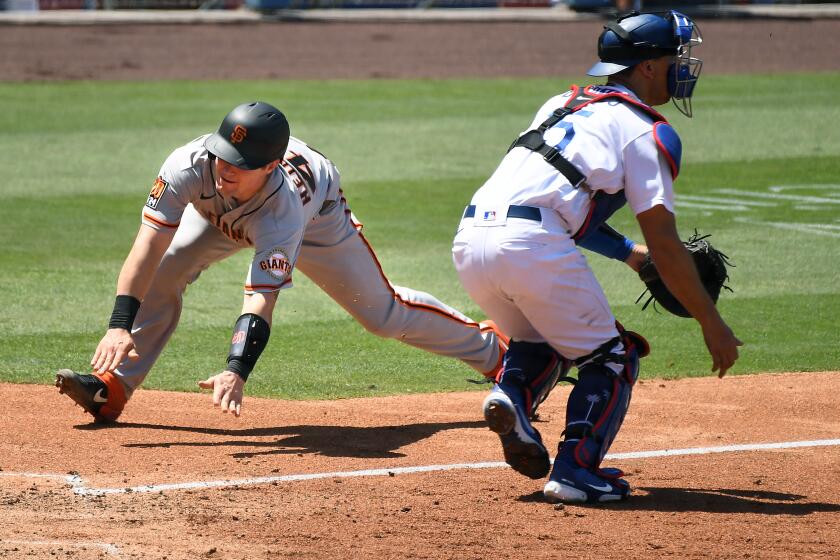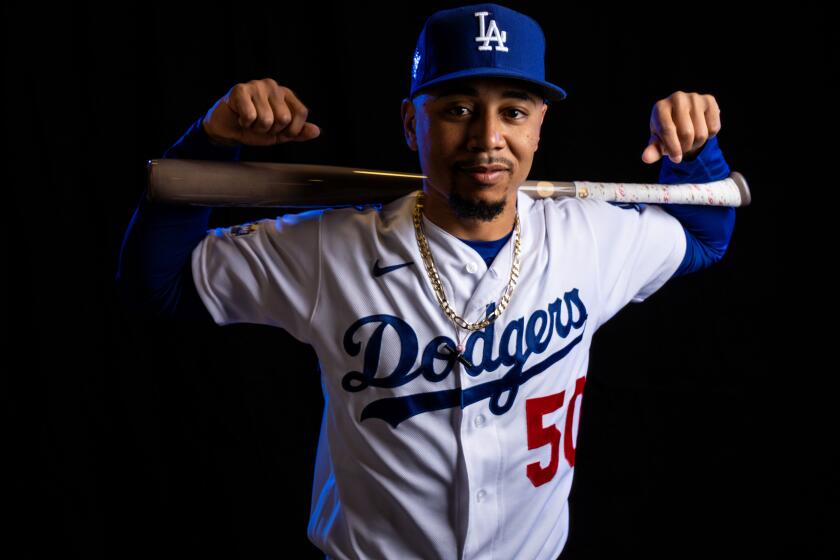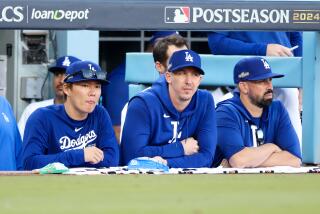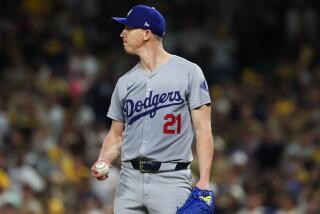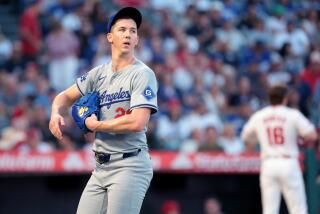Rotation is the biggest question for Dodgers early in season
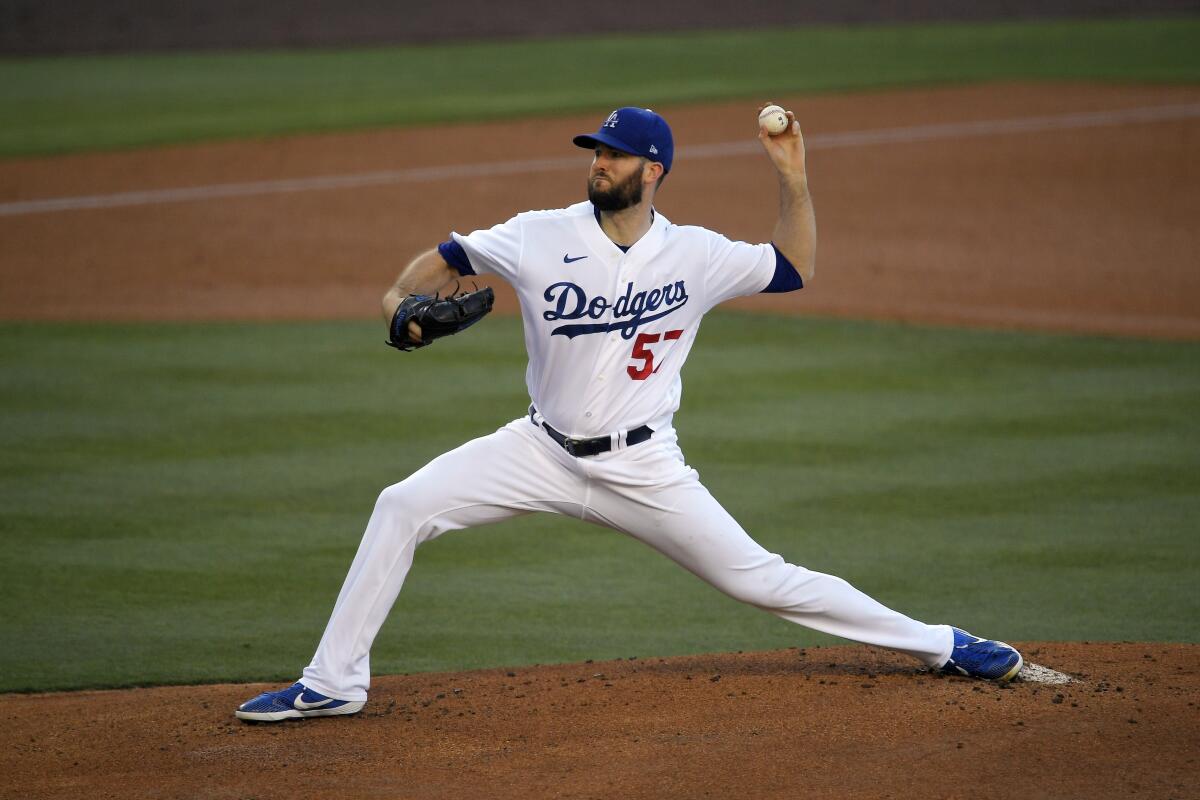
- Share via
Three games into the season and there’s already trouble for the Dodgers.
All winter, all spring and halfway through the summer, the problem was staring everyone in the face.
The trap door was concealed by a blanket of excitement over not only how the Dodgers finally, finally, finally traded one of their precious homegrown talents for a superstar in Mookie Betts, but how that superstar was open to a Guggenheim delayed-compensation program that will spread his $65-million signing bonus over 15 years.
The concerns that existed were largely centered on the propane tank of a bullpen, a reasonable response to the franchise’s recent postseason history.
But the uncomfortable truth was exposed Saturday in a 5-4 defeat to the San Francisco Giants at Dodger Stadium.
The Dodgers’ rotation is … well, what, exactly?
And therein lies the problem.
The worry isn’t so much that Alex Wood lost the strike zone and was charged with three runs in a three-inning start. Games like that happen.
What’s disconcerting are the number of question marks up and down the rotation.
The Dodgers fall 5-4 to the Giants, committing too many mistakes after picking up comfortable victories in the first two games of the season.
Starting pitching has historically been a strong point for the Dodgers, but the group is threatening to erase the advantage created by their lineup, which is the best in baseball.
When the Dodgers boast of their pitching depth, what they’re really talking about is regular-season pitching depth. Counting the likes of Tony Gonsolin, they have what looks like a never-ending parade of pitchers who can take the mound in a regular-season game and give them a chance to win.
This is a luxury most other teams don’t have.
As the winners of seven consecutive division championships and two of the last three National League pennants, however, the Dodgers are focused on October.
The postseason is why they acquired a high-end talent like Betts.
Walker Buehler established himself as the team’s ace last season, starting Game 1 of their NL Division Series against the Washington Nationals. Buehler also started Game 5 and departed the eventual loss with a lead. And when the Dodgers return to the postseason again this year, he will again take the ball in their most critical games.
But who’s the No. 2 starter behind Buehler? Who’s No. 3?
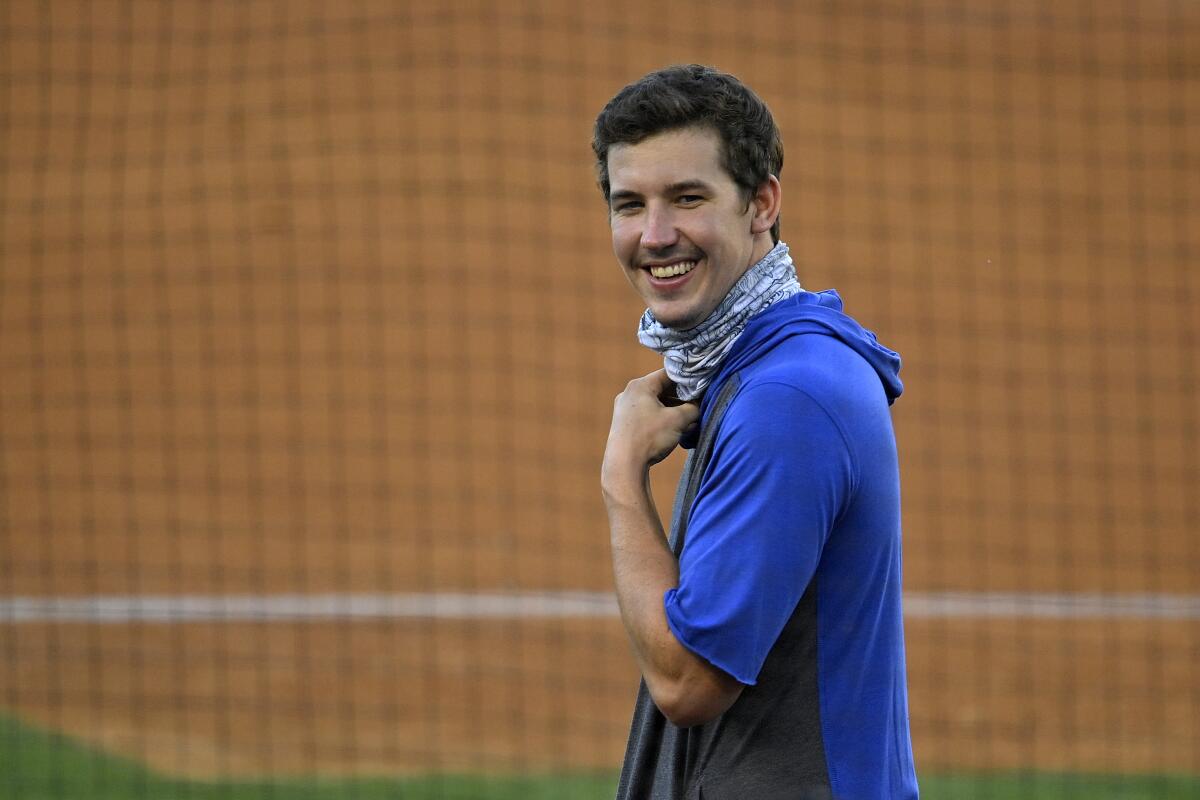
The last time the Dodgers had two ace-caliber pitchers was in 2015, when Clayton Kershaw and Zack Greinke were paired atop the rotation.
The team essentially traded one problem for another after that, its rotation improving its balance but becoming less potent up front.
Two of the four pitchers who started in the NLDS last year aren’t on the roster anymore, as Hyun-Jin Ryu moved to the Toronto Blue Jays and Rich Hill to the Minnesota Twins.
David Price, a part of the Betts trade who was expected to fortify the rotation, opted not to play this season because of concerns about the coronavirus pandemic.
And the situation could be worse.
In an effort to unload Joc Pederson’s $7.75-million salary, the Dodgers agreed to throw in Ross Stripling in a trade with the Angels. In what in retrospect was a stroke of extreme luck, the agreed-upon deal was detonated by Angels owner Arte Moreno. Stripling started the second game of the season.
Stripling could once again be an All-Star, which he was in 2018. Or he could be a swingman, which is what he’s been at every other point in his career.
He isn’t the only mystery in the rotation.
Outside of Buehler, the starters generally are in one of two categories: the ones with particularly disconcerting medical records and the ones short on experience.
Before the game Saturday, Kershaw played catch in the outfield. He threw with a decent level of conviction, which appeared to support his claim that he would return soon from the stiff back that prevented him from making his opening day start.
The new Dodgers owners said in 2012 they’d rebuild quickly, replenish the farm system, build a sustainable winner, and invest in the right player. They are 4 for 4.
Still, at 32 and with more than 2,400 innings pitched in the majors, nothing is guaranteed for Kershaw.
Even less is guaranteed of Wood, who was sidelined for the majority of last season because of back pain. Wood pitched only seven games for the Cincinnati Reds last year and returned to the Dodgers as a free agent.
The left-hander blamed his performance Saturday on his plan of attack, which included a reliance on breaking balls early in counts to offset the Giants’ heavily right-handed-hitting lineup. Wood threw 50 pitches in the first two innings.
In a postgame news conference on a Zoom webinar, Wood vowed improvement.
“I think for anybody that knows me, I wear days like this as hard as anybody,” he said. “I’ll deal with my feelings when I leave the park and be ready to go back to work and get ready for my next one.”
Wood’s emotional resilience is beyond reproach. When he failed to make the Dodgers’ rotation out of spring training in 2017, he didn’t complain. Instead, he waited for an opportunity and made the most of it when it came, earning a place on the All-Star team. In the World Series that season, he was the only Dodgers starter to pitch well against the trash-can thumping Astros in Houston.
But questions remain about how he will respond physically after missing the majority of last season.
Already feeling better after suffering a back injury and missing his opening day start, the Dodgers’ Clayton Kershaw believes he will return soon.
As for Julio Urías and Dustin May, exuberance over their high-ceiling talent has to be tempered by the reality they have never been counted on the way they will be this season. Urías, the 23-year-old former teenage prodigy, will make his first start Sunday in the series finale against the Giants.
Something else: Buehler isn’t pitching until the team’s fifth game, which is Tuesday in Houston, because his arm isn’t as built up as those of the other starters.
Manager Dave Roberts nonetheless declared he is “very certain” of what the Dodgers have. “I think our starting pitching depth,” Roberts said, “I’m really comfortable with it.”
He almost has to be. In a typical season, he would have months to figure out what he has. In a 60-game season, he might not even have weeks.
More to Read
Are you a true-blue fan?
Get our Dodgers Dugout newsletter for insights, news and much more.
You may occasionally receive promotional content from the Los Angeles Times.

